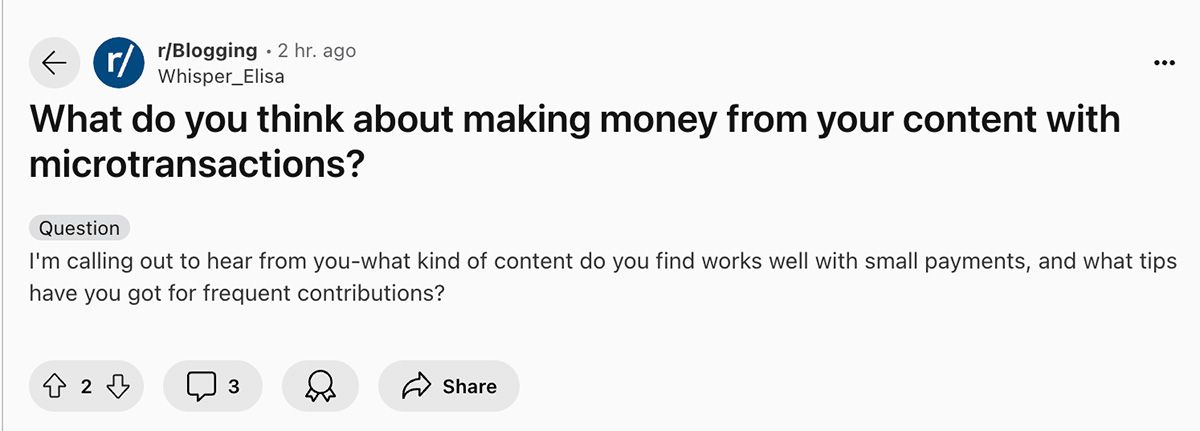Arguments For and Against Microtransactions and Pay-per-article Schemes
What if every article on a blog was a miniature paywall collecting revenue? That's exactly what microtransactions might be.

Could accepting tiny little payments of just a few pennies each be a way to unlock loads of blog revenue?
That is the question at the heart of a recent Reddit post, "What do you think about making money from your content with microtransactions?"

In the context of monetizing a blog, the term "microtransactions" often describes a low-cost paywall. The idea is that readers pay a small fee ranging from a few cents to about a dollar to access a single article.
Let's consider some arguments for and against this pay-per-article concept —the pros and cons if you will.
Pro No. 1: Replace Advertising
Advertising is one of the most common ways to monetize a blog. If you need proof, visit any food blog using Mediavine or Raptive for ad placement.
Recently, I visited just such a site for a sauce recipe and found ten blinking and flashing ad units, including one video preroll on autoplay. It promised to switch to "my latest recipe video" after 15 sections.
There was an advertisement at the top, middle, and bottom of the recipe. The ingredient list had an ad too. A few more ads were vertically arranged in the sidebar. There was a video ready to promote Chevrolet inserted into the comment section. And a fixed banner at the bottom of the page alternated between images and videos.
AT&T, Target, Chevy, Walmart, Zales, Ultra Beauty, Aveeno Kids, Vrbo, a local restaurant, and —as proof that I was being specifically targeted— Aviation Gin all made appearances in the rotating ad slots.
Several bloggers have told me they earn between $25 and $40 per 1,000 site visitors employing the multiplicity of ads just described. At the high end, that is 4 cents per site visitor.
Readers and publishers alike would be better off if a nanotransaction could successfully replace ten ad spots.
Pro No. 2: A Flexible Subscription
Lots of folks subscribe to content. They might have a physical magazine subscription, a Netflix subscription, or even a paid newsletter subscription.
The model works well. Publishers get paid. Subscribers get content.
Except I don't read "Business Insider" because I don't want to spend $49 a year. I don't know why it's an issue for me. I pay "The Wall Street Journal," "AdAge," and "Wine Enthusiast" without hesitation. But for some reason, $49 feels too expensive. If, however, I could pay per article via a microtransaction, I would probably do it from time to time.
It would be a flexible and functional subscription option for me. I get access without commitment, and the publication gets an opportunity to show me just how great it is.
Pro No. 3: Data
Simply put, the granular, article-by-article purchase data a blogger could collect from microtransactions might be priceless when it comes to building a content strategy.
Knowing what a reader will pay for goes a long way toward understanding what kind of digital products or services to offer too.
Con No. 1: SEO
While a paywall does not necessarily impact search engine optimization or a site's ability to rank in Google or other search engines, it can.
It all comes down to how the paywall is implemented. Is it down on the server or the client? Does it allow for indexing? Does it impact site speed? Does it create a lot of bounces? You get the idea.
Con No. 2: Friction
In Pro No. 1 above, I mentioned that microtransactions could be a good replacement for advertising. The recipe site with ten ads was difficult to use. It created a lot of friction, but so did the New York Times recipe pages, which are behind a paywall.
The experience of needing to pay for each article —or each recipe— absolutely interrupts what the site visitor is trying to accomplish.
Someone is looking for a sauce recipe to continue with the example and now has to stop and pull out a credit card to unlock the secret ingredient.
It might be the case that adding a nanotransactional paywall has the effect of killing your blog, thanks to that extra friction.
Con No. 3: It's Complicated
There are at least five ways to implement a paywall for blog content in general, and things become significantly more difficult when you want to build a paywall per article versus the more common all-or-nothing subscription.